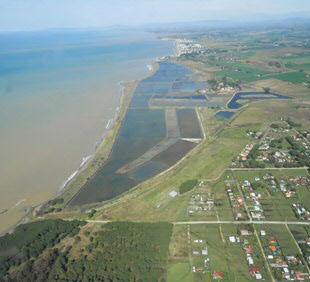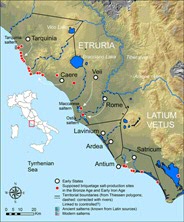Currently available evidence
Along the Tyrrhenian coast of Latium Vetus and Etruria multiple sites with dumps of reddish jars are archaeologically attested. These can be tentatively linked to the briquetage technique (Alessandri, 2013; Belardelli, 2013; Pacciarelli, 2010). In Etruria, their appearance is contemporary with the birth of the early states of Tarquinia, Cerveteri and Veio (10th century BCE). In Latium Vetus, their chronology spans from the Middle Bronze Age (17th c. BCE) to the Archaic period (6th c. BCE). Evidence about the introduction of the saltern production mode comes from the Maccarese lagoon, north of Tiber’s mouth. Here hydraulic structures of a saltern, (first half of the 1st century CE) were attested (Grossi et al., 2015). However, palynological data point at increased salinity already around 2600 calBP (end of 7th century BCE), caused by artificial opening the lagoon to let in seawater (Di Rita et al., 2010). The southern saltern, controlled by Rome according to the ancient sources, has not been identified yet, but a similar increase in salinity was detected in pollen records from the Ostia lagoon (700-600 BCE) due to its opening (Bellotti et al., 2011).

| Last modified: | 22 November 2021 11.12 a.m. |

